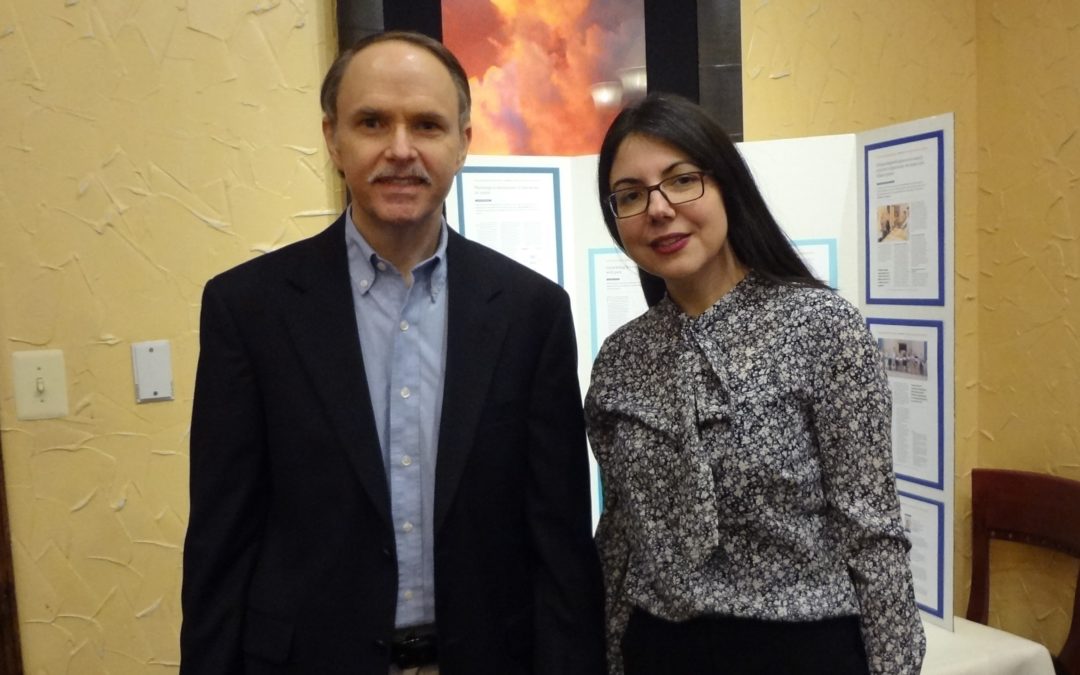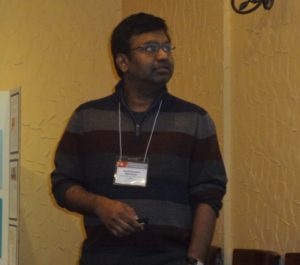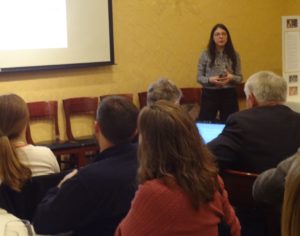Hyperacusis Research continued the focus on collaboration with researchers at the 2019 Association of Research for Otolaryngology Midwinter meeting.
Pictured at top: Bryan Pollard and Dr. Luana Colloca
A key part of the collaboration was the Hyperacusis Alliance dinner event, where more than 30 researchers and supporters came together for the evening. The theme was “Unravelling the Mystery of Hyperacusis with Pain.”
Dr. Steven Barad started the evening by sharing the impact of hyperacusis with pain on his son, who acquired hyperacusis seven years ago. He shared how frustrating it was to watch his son suffer while unsuccessfully pursuing all medically available options for relief. His son then shared about the impact via video. He described the sharp, burning pain that is initiated with everyday noises and how several significant setbacks have made progress difficult. The life-altering impact hyperacusis has on so many sufferers is the reason our research is so critical. Our goal is to uncover the mechanism behind this pain and find relief strategies that work and ultimately a cure.
Dr. Senthil Manohar described his research at the University at Buffalo on a novel Auditory Nociception Test for Pain Hyperacusis. Senthil’s work utilizes a thermal pain that is common in the field of pain research. He demonstrated different responses for sounds below 100 dB and sounds above 110 dB. But after hearing loss was induced, the responses between the sound levels were similar. Next, long-lasting sound-evoked pain sensitivity (hyperalgesia) was induced pharmacologically by an opioid. These results suggest that prior opioid treatment may exacerbate pain hyperacusis and lays the foundation for a hyperacusis pain model that other researchers can use to uncover more of the mechanism underlying the source of pain.
Dr. Luana Colloca, Associate Professor from the University of Maryland, described her pain research which has shown impacts of what has been known as the placebo effect. While pain researchers had long assumed that the impact of a placebo (such as a sugar pill in a clinical drug trial) was entirely psychological, recent research has shown endogenous opioids are released in some patients, creating noticeable relief. There may be ways to harness endogenous modulatory mechanisms to improve clinical outcomes in pain management.
Most importantly, for hyperacusis with pain, other studies focused on those with chronic pain. In chronic pain research, repeated pain signals over multiple days can increase a patient’s pain sensation. Thus a cycle of pain can be very difficult to interrupt due to increasing sensitivity. This is an area that needs significant further exploration when it comes to hyperacusis with pain.
Dr. Craig Formby described the breakthrough clinical trial that he and Dr. David Eddins from the University of South Florida are leading for a novel hyperacusis device. Dr. Formby has participated in prior Hyperacusis Research events where he heard the stories of those suffering who could not even consider going out into their loud world and how setbacks continued to hinder progress. He helped develop this device to give patients a technological solution to the challenging choice between no protection versus ear plugs. Some patients struggle with a binary choice for something like a family gathering: : “Do I wear ear protection in this unknown situation to ensure no setbacks but have difficulty communicating, or do I use no ear protection to hear well but put myself at risk of the loud noise?”
This device is designed for protection whenever a sound is above an individual’s comfort level. Sounds below the threshold will be heard normally. Furthermore, it has a noise generator to enable sound therapy for quieter environments. The clinical trial has started in Tampa, FL You can find out more here.
Marlies Knipper, PhD, University of Tubingen, closed the evening with an in-depth technical review of her team’s work related to the central gain model of hyperacusis. Her research suggests that while enhanced central neural gain compensates for acoustic trauma-induced cochlear impairment, it does not likely correlate with tinnitus and hyperacusis. The work includes extensive Auditory Brainstem Response (ABR) testing, detailed assessments of inner hair cell ribbon synapses and analysis of Arc immunoreactive cells in the Auditory Brainstem. While most other research continues to grow support for a central gain model playing a primary role in hyperacusis, this research raises questions on the simplicity of that model. One critical question that has been problematic is that, according to the central gain concept, everyone with hearing loss should experience tinnitus and most should have some sound sensitivity. Since this is not the case, it is clear that more variables are involved and this type of critical assessment is needed to ensure that unknown factors are not missed.
Additional Collaboration at ARO
Hyperacusis Research collaborates throughout the ARO conference with individual researchers and small groups to support ongoing research efforts and help initiate new research ideas. A few meetings are highlighted below.
Bryan was joined by Iver Juster in a meeting with Megan Wood and Paul Fuchs from Johns Hopkins University and Tanisha Hammill from the DOD Hearing Center of Excellence. Research at Johns Hopkins has been critical to uncovering the role of Type II nerve fibers in the cochlea. Paul and Megan’s work indicates these Type II fibers carry pain signals in the presence of very loud noise. Bryan discussed the additional work needed to uncover direct links between Type II fibers and hyperacusis with pain.
The Hearing Center of Excellence (HCE) is supporting research essential to helping the many military members affected by auditory disorders. A critical next step is to determine the prevalence of hyperacusis in the military. We’re excited to know that the analysis for hyperacusis prevalence has started.

Kelly Radziwon, Steve Barad, Senthilvelan Manohar, Ben Auerbach, Michael Maholchic, Iver Juster, Bryan Pollard, Betsy Maholchic, Cilia Zhang
The team at the University of Buffalo, led by Dr. Rich Salvi (not pictured), has been vital to many aspects of research related to hyperacusis. Bryan and several supporters, along with board member Michael Maholchic, met with the team to review several aspects of their work. Ben Auerbach has been researching auditory hypersensitivity and circuit disruptions in Fragile X syndrome to improve understanding of the pathophysiology of autism spectrum disorders.. Since many with autism suffer from sound sensitivities, research in this area may lead to discoverers that benefit those with noise-induced hyperacusis. Hyperacusis Research is grateful for all that this team has contributed to advancing our understanding of hyperacusis.






